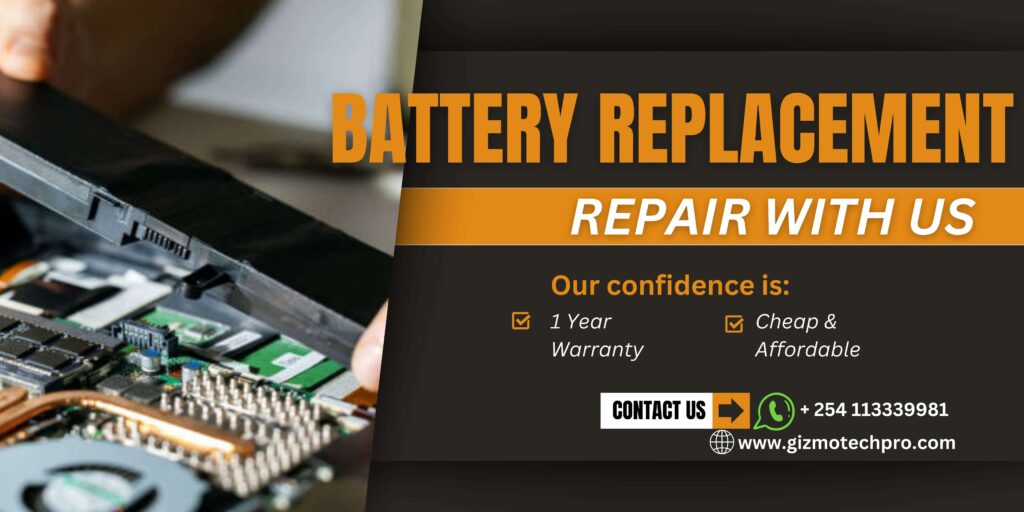blog
LAPTOP BATTERY REPLACEMENT. THE ULTIMATE GUIDE TO LAPTOP BATTERY REPLACEMENT
Understanding Laptop Battery Basics
How Laptop Batteries Work
Laptop batteries are intricate assemblies designed to provide portable power to your device. They are composed of several key components:
- Cells: The fundamental units of a battery, which store and release electrical energy. Each cell contains chemicals that react to produce electricity.
- Battery Management System (BMS): This crucial component monitors the battery’s health and manages its charging and discharging cycles, ensuring optimal performance and safety.
- Protective Circuitry: Prevents overcharging, deep discharge, and short circuits, safeguarding both the battery and the laptop.
Two primary types of laptop batteries dominate the market:
- Lithium-Ion (Li-Ion): Known for its high energy density and relatively low self-discharge rate. Li-Ion batteries are prevalent due to their light weight and longer life cycle.
- Lithium-Polymer (Li-Po): These batteries offer flexibility in shape and size, providing manufacturers with more design options. Li-Po batteries are lighter and can be shaped to fit various laptop designs, though they generally have a lower energy density compared to Li-Ion batteries.
Signs Your Laptop Battery Needs Replacing
Several indicators suggest that your laptop battery may be nearing the end of its life:
- Rapid Discharge: If your laptop battery drains significantly faster than usual, even with minimal use, it may be a sign of degradation.
- Swelling: A swollen battery is a critical warning sign. Physical bulging can occur due to overheating or overcharging and poses a safety risk.
- Overheating: Excessive heat during charging or use can indicate that the battery is failing and should be replaced promptly.
To accurately assess your battery’s health:
- Built-In Diagnostics Tools: Most laptops come with software tools that monitor battery health and performance. These tools can provide detailed reports on charge cycles, capacity, and overall condition.
Steps for Replacing Your Laptop Battery
Preparation for Battery Replacement
Before replacing a laptop battery, ensure you have the appropriate tools and take necessary precautions:
- Tools Required: You will need screwdrivers, typically a Phillips head, and anti-static wristbands to prevent electrostatic discharge that could damage sensitive components.
- Safety Precautions: Handle the battery carefully to avoid short-circuiting or damaging it. Always work in a static-free environment and turn off the laptop before beginning.
Detailed Replacement Procedure
- Removing the Old Battery: Begin by turning off the laptop and disconnecting it from any power sources. Remove the screws securing the battery compartment, carefully lift out the old battery, and disconnect it from the laptop’s internal connectors.
- Installing the New Battery: Place the new battery in the compartment, align it with the connectors, and ensure a secure fit. Reattach the screws and power on your laptop to check that the new battery is functioning correctly.
Choosing the Right Replacement Battery
Finding a Compatible Battery
Selecting the right replacement battery involves:
- Ensuring Compatibility: Verify that the new battery matches the model specifications of your laptop. Compatibility is crucial to avoid potential damage and ensure proper performance.
- OEM vs. Aftermarket Batteries: Original Equipment Manufacturer (OEM) batteries are made by the laptop’s manufacturer and typically offer higher reliability and longer life. Aftermarket batteries can be more affordable but may vary in quality and performance.
Where to Buy Replacement Batteries
- Authorized Retailers vs. Online Marketplaces: Purchasing from authorized retailers ensures that you receive genuine and high-quality batteries. Online marketplaces can offer competitive prices but require careful evaluation of seller reviews and product ratings to avoid counterfeit or substandard products.
Maintaining Battery Health
Best Practices for Battery Use
To prolong battery life and maintain performance:
- Optimal Charging Habits: Avoid overcharging your battery. Most modern laptops are designed to stop charging when full, but it’s beneficial to unplug the device once it reaches 100%. Additionally, try to keep your battery’s charge between 20% and 80% to extend its lifespan.
- Preventing Common Issues: Manage heat by keeping your laptop well-ventilated and avoiding placing it on soft surfaces that can block airflow. Proper storage, especially when not in use for extended periods, helps prevent degradation.
Long-Term Care for Your Battery
- Regular Maintenance Tips: Periodically calibrate your battery by fully charging and discharging it to maintain accurate battery readings. Keep your laptop’s software updated to optimize power management.
- What to Do If Performance Degrades: If you notice a significant drop in performance, reassess your battery’s health using diagnostic tools. If issues persist, it may be time for a replacement or a professional evaluation.
When to Seek Professional Help
Deciding Between DIY and Professional Services
- When DIY Replacement is Feasible: If you are comfortable with basic repairs and have the right tools, replacing the battery yourself can be cost-effective. Ensure you follow the correct procedures to avoid damaging your laptop.
- When to Seek Expert Help: For complex issues or if you are uncertain about performing the replacement, consulting a professional technician is advisable. They can provide a thorough diagnosis and ensure that the replacement is done correctly.
- How to Find a Reputable Technician: Look for technicians with good reviews and certifications. A reliable service provider should offer warranties on their work and provide clear explanations of the repair process.
Cost Considerations
- Comparing the Cost of Professional Repair vs. Battery Replacement: Evaluate the cost of professional repair services against the price of a new battery. Sometimes, professional services may be more economical if they also offer warranty coverage.
- Evaluating the Financial Impact: Consider the long-term financial impact of repairing versus replacing your laptop. If the cost of repair approaches or exceeds the price of a new laptop, replacement might be a more viable option.

